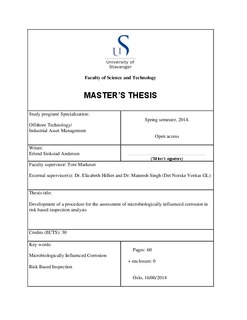| dc.contributor.author | Andersen, Erlend Stokstad | |
| dc.date.accessioned | 2014-09-16T10:55:39Z | |
| dc.date.available | 2014-09-16T10:55:39Z | |
| dc.date.issued | 2014-06-16 | |
| dc.identifier.uri | http://hdl.handle.net/11250/219874 | |
| dc.description | Master's thesis in Offshore technology : industrial asset management | nb_NO |
| dc.description.abstract | Operating offshore oil and gas production facilities is often associated with high risk. In order to manage the risk, operators commonly use aids to support decision making in the
establishment of a maintenance and inspection strategy. Risk Based Inspection (RBI) analysis is widely used in the offshore industry as a means to justify the maintenance and inspection strategy adopted. The purpose of this thesis is to develop a procedure for the assessment of microbiologically influenced corrosion in RBI analysis.
RBI analysis is a decision making technique that enables asset managers to identify their most critical systems and components, with regards to safety, environment and business (DNV, 2010). In this thesis, risk is considered in accordance with DNV GL practise as a two dimensional combination of probability of failure and consequence if failure. Thus, the RBI analysis is based upon this risk picture as well.
Microbiologically Influenced Corrosion (MIC) is a degradation mechanism that has received increased attention from corrosion engineers and asset operators in the recent years. In the thesis, the most important aspect of MIC is presented and discussed. Further, previous models that have been developed in order to assess the impact of MIC on asset integrity are presented. From a risk perspective, MIC is not satisfactorily assessed by the current models and the models lack a proper view of the MIC threat. Therefore, a review of parameters that affect MIC is presented.
The mapping and identification of parameters is based on the review of past models and
extensive literature study of the subject. The parameters are discussed and subsequently
combined in a suggested procedure that allows assessment of MIC in a RBI analysis. The
procedure is sub-divided into one screening step and one detailed assessment, which fits the recommended approach to assess risk in a RBI analysis.
Interface between the suggested procedure and the RBI concept is discussed. Several
recommendations are made in the identification of what, when, where and how to inspect, as well as what to report. Lastly, an example that illustrates application of the procedure is given. | nb_NO |
| dc.language.iso | eng | nb_NO |
| dc.publisher | University of Stavanger, Norway | nb_NO |
| dc.relation.ispartofseries | Masteroppgave/UIS-TN-IKM/2014; | |
| dc.rights | Attribution-NonCommercial-NoDerivs 3.0 Norway | * |
| dc.rights.uri | http://creativecommons.org/licenses/by-nc-nd/3.0/no/ | * |
| dc.subject | offshore teknologi | nb_NO |
| dc.subject | driftsledelse | nb_NO |
| dc.title | Development of a procedure for the assessment of microbiologically influenced corrosion | nb_NO |
| dc.type | Master thesis | nb_NO |
| dc.subject.nsi | VDP::Technology: 500::Marine technology: 580::Offshore technology: 581 | nb_NO |
| dc.source.pagenumber | 60 | nb_NO |

